Intrarenal Dopaminergic System Is Dysregulated in SS-Resp18mutant Rats
Abstract
1. Introduction
2. Materials and Methods
2.1. Animals
2.2. Food and Water Intake
2.3. Vascular Myograph
2.4. Glomerular Filtration Rate in Conscious Rats
2.5. Immunohistochemistry of the Kidney
2.6. Measurement of Dopamine
2.7. Immunoblotting
2.8. Sodium Measurement
2.9. Isolation and Culture of Renal Proximal Tubule Cells and Dopamine Release Assay
2.10. RNA Isolation and Quantitative Real-Time-PCR
2.11. Statistical Analysis
3. Results
3.1. SS-Resp18mutant Rats Have Vascular Dysfunction and Reduced Glomerular Filtration Rate (GFR)
3.2. SS-Resp18mutant Rats Have Alteration in the Pressure–Natriuresis Response
3.3. SS-Resp18mutant Rat Kidneys Exhibit an Increase in Macrophage Infiltration
3.4. Dysregulation of Renal Dopaminergic System in SS-Resp18mutant Rats
4. Discussion
5. Conclusions
Author Contributions
Funding
Institutional Review Board Statement
Data Availability Statement
Acknowledgments
Conflicts of Interest
References
- Kelly, D.M.; Rothwell, P.M. Does Chronic Kidney Disease Predict Stroke Risk Independent of Blood Pressure?: A Systematic Review and Meta-Regression. Stroke 2019, 50, 3085–3092. [Google Scholar] [CrossRef] [PubMed]
- Diener, H.C.; Hankey, G.J. Primary and Secondary Prevention of Ischemic Stroke and Cerebral Hemorrhage: JACC Focus Seminar. J. Am. Coll. Cardiol. 2020, 75, 1804–1818. [Google Scholar] [CrossRef] [PubMed]
- Maïer, B.; Kubis, N. Hypertension and Its Impact on Stroke Recovery: From a Vascular to a Parenchymal Overview. Neural Plast. 2019, 2019, 6843895. [Google Scholar] [CrossRef] [PubMed]
- Saran, R.; Robinson, B.; Abbott, K.C.; Agodoa, L.Y.C.; Bhave, N.; Bragg-Gresham, J.; Balkrishnan, R.; Dietrich, X.; Eckard, A.; Eggers, P.W.; et al. UA Renal Data System 2017 Annual Data Report: Epidemiology of Kidney Disease in the United States. Am. J. Kidney Dis. 2018, 71, A7. [Google Scholar] [CrossRef]
- Kumarasamy, S.; Waghulde, H.; Gopalakrishnan, K.; Mell, B.; Morgan, E.; Joe, B. Mutation within the hinge region of the transcription factor Nr2f2 attenuates salt-sensitive hypertension. Nat. Commun. 2015, 6, 6252. [Google Scholar] [CrossRef] [PubMed]
- Cook, N.R.; Appel, L.J.; Whelton, P.K. Lower levels of sodium intake and reduced cardiovascular risk. Circulation 2014, 129, 981–989. [Google Scholar] [CrossRef] [PubMed]
- Sanada, H.; Jones, J.E.; Jose, P.A. Genetics of salt-sensitive hypertension. Curr. Hypertens. Rep. 2011, 13, 55–66. [Google Scholar] [CrossRef]
- Hall, J.E.; Granger, J.P.; do Carmo, J.M.; da Silva, A.A.; Dubinion, J.; George, E.; Hamza, S.; Speed, J.; Hall, M.E. Hypertension: Physiology and pathophysiology. Compr. Physiol. 2012, 2, 2393–2442. [Google Scholar]
- Migdal, K.U.; Babcock, M.C.; Robinson, A.T.; Watso, J.C.; Wenner, M.M.; Stocker, S.D.; Farquhar, W.B. The impact of high dietary sodium consumption on blood pressure variability in healthy, young adults. Am. J. Hypertens. 2020, 33, 422–429. [Google Scholar] [CrossRef]
- Hottenga, J.J.; Boomsma, D.I.; Kupper, N.; Posthuma, D.; Snieder, H.; Willemsen, G.; de Geus, E.J. Heritability and stability of resting blood pressure. Twin Res. Hum. Genet. 2005, 8, 499–508. [Google Scholar] [CrossRef]
- Cecelja, M.; Keehn, L.; Ye, L.; Spector, T.D.; Hughes, A.D.; Chowienczyk, P. Genetic aetiology of blood pressure relates to aortic stiffness with bi-directional causality: Evidence from heritability, blood pressure polymorphisms, and Mendelian randomization. Eur. Heart J. 2020, 41, 3314–3322. [Google Scholar] [CrossRef] [PubMed]
- Haque, M.Z.; Ares, G.R.; Caceres, P.S.; Ortiz, P.A. High salt differentially regulates surface NKCC2 expression in thick ascending limbs of dahl salt-sensitive and salt-resistant rats. Am. J. Physiol. Renal Physiol. 2011, 300, F1096–F1104. [Google Scholar] [CrossRef] [PubMed]
- Wade, B.; Petrova, G.; Mattson, D.L. Role of immune factors in angiotensin II-induced hypertension and renal damage in dahl salt-sensitive rats. Am. J. Physiol. Regul. Integr. Comp. Physiol. 2018, 314, R323–R333. [Google Scholar] [CrossRef] [PubMed]
- Huang, B.; Cheng, Y.; Usa, K.; Liu, Y.; Baker, M.A.; Mattson, D.L.; He, Y.; Wang, N.; Liang, M. Renal tumor necrosis factor contributes to hypertension in Dahl salt-sensitive rats. Sci. Rep. 2016, 6, 21960. [Google Scholar] [CrossRef]
- Chen, C.C.; Geurts, A.M.; Jacob, H.J.; Fan, F.; Roman, R.J. Heterozygous knockout of transforming growth factor-β1 protects Dahl S rats against high salt-induced renal injury. Physiol. Genomics 2013, 45, 110–118. [Google Scholar] [CrossRef][Green Version]
- Rapp, J.P. Genetic analysis of inherited hypertension in the rat. Physiol. Rev. 2000, 80, 135–172. [Google Scholar] [CrossRef]
- Garrett, M.R.; Meng, H.; Rapp, J.P.; Joe, B. Locating a blood pressure quantitative trait locus within 117 Kb on the rat genome: Substitution mapping and renal expression analysis. Hypertension 2005, 45, 451–459. [Google Scholar] [CrossRef]
- Mattson, D.L.; Dwinell, M.R.; Greene, A.S.; Kwitek, A.E.; Roman, R.J.; Jacob, H.J.; Cowley, A.W., Jr. Chromosome substitution reveals the genetic basis of Dahl salt-sensitive hypertension and renal disease. Am. J. Physiol. Renal Physiol. 2008, 295, F837–F842. [Google Scholar] [CrossRef]
- Darlington, D.N.; Mains, R.E.; Eipper, B.A. Location of neurons that express regulated endocrine-specific protein-18 in the rat diencephalon. Neuroscience 1996, 71, 477–488. [Google Scholar] [CrossRef]
- Lee, J.W.; Chou, C.L.; Knepper, M.A. Deep sequencing in microdissected renal tubules identifies nephron segment-specific transcriptomes. J. Am. Soc. Nephrol. 2015, 26, 2669–2677. [Google Scholar] [CrossRef]
- Kumarasamy, S.; Waghulde, H.; Cheng, X.; Haller, S.T.; Mell, B.; Abhijith, B.; Ashraf, U.M.; Atari, E.; Joe, B. Targeted disruption of regulated endocrine-specific protein (Resp18) in Dahl SS/Mcw rats aggravates salt-induced hypertension and renal injury. Physiol. Genomics 2018, 50, 369–375. [Google Scholar] [CrossRef] [PubMed]
- Schiller, M.R.; Mains, R.E.; Eipper, B.A. A novel neuroendocrine intracellular signaling pathway. Mol. Endocrinol. 1997, 11, 1846–1857. [Google Scholar] [CrossRef] [PubMed]
- Armando, I.; Konkalmatt, P.; Felder, R.A.; Jose, P.A. The renal dopaminergic system: Novel diagnostic and therapeutic approaches in hypertension and kidney disease. Transl. Res. 2015, 165, 505–511. [Google Scholar] [CrossRef] [PubMed][Green Version]
- Asghar, M.; Tayebati, S.K.; Lokhandwala, M.F.; Hussain, T. Potential dopamine-1 receptor stimulation in hypertension management. Curr. Hypertens. Rep. 2011, 13, 294–302. [Google Scholar] [CrossRef]
- Harris, R.C.; Zhang, M.Z. Dopamine, the kidney, and hypertension. Curr. Hypertens. Rep. 2012, 14, 138–143. [Google Scholar] [CrossRef]
- Zhang, M.Z.; Yao, B.; Wang, S.; Fan, X.; Wu, G.; Yang, H.; Yin, H.; Yang, S.; Harris, R.C. Intrarenal dopamine deficiency leads to hypertension and decreased longevity in mice. J. Clin. Invest. 2011, 121, 2845–2854. [Google Scholar] [CrossRef]
- Chugh, G.; Pokkunuri, I.; Asghar, M. Renal dopamine and angiotensin II receptor signaling in age-related hypertension. Am. J. Physiol. Renal Physiol. 2013, 304, F1–F7. [Google Scholar] [CrossRef]
- Geurts, A.M.; Cost, G.J.; Remy, S.; Cui, X.; Tesson, L.; Usal, C.; Menoret, S.; Jacob, H.J.; Anegon, I.; Buelow, R. Generation of gene-specific mutated rats using zinc-finger nucleases. Methods Mol. Biol. 2010, 597, 211–225. [Google Scholar]
- Ellery, S.J.; Cai, X.; Walker, D.D.; Dickinson, H.; Kett, M.M. Transcutaneous measurement of glomerular filtration rate in small rodents: Through the skin for the win? Nephrology 2015, 20, 117–123. [Google Scholar] [CrossRef]
- Schock-Kusch, D.; Xie, Q.; Shulhevich, Y.; Hesser, J.; Stsepankou, D.; Sadick, M.; Koenig, S.; Hoecklin, F.; Pill, J.; Gretz, N. Transcutaneous assessment of renal function in conscious rats with a device for measuring FITC-sinistrin disappearance curves. Kidney Int. 2011, 79, 1254–1258. [Google Scholar] [CrossRef]
- Schock-Kusch, D.; Sadick, M.; Henninger, N.; Kraenzlin, B.; Claus, G.; Kloetzer, H.M.; Weiss, C.; Pill, J.; Gretz, N. Transcutaneous measurement of glomerular filtration rate using FITC-sinistrin in rats. Nephrol. Dial. Transplant. 2009, 24, 2997–3001. [Google Scholar] [CrossRef] [PubMed]
- Das, S.C.; Althobaiti, Y.S.; Alshehri, F.S.; Sari, Y. Binge ethanol withdrawal: Effects on post-withdrawal ethanol intake, glutamate-glutamine cycle and monoamine tissue content in p rat model. Behav. Brain Res. 2016, 303, 120–125. [Google Scholar] [CrossRef] [PubMed]
- Almalki, A.H.; Das, S.C.; Alshehri, F.S.; Althobaiti, Y.S.; Sari, Y. Effects of sequential ethanol exposure and repeated high-dose methamphetamine on striatal and hippocampal dopamine, serotonin and glutamate tissue content in wistar rats. Neurosc. Lett. 2018, 665, 61–66. [Google Scholar] [CrossRef]
- Liu, J.; Yan, Y.; Liu, L.; Xie, Z.; Malhotra, D.; Joe, B.; Shapiro, J.I. Impairment of Na/K-ATPase signaling in renal proximal tubule contributes to Dahl salt-sensitive hypertension. J. Biol. Chem. 2011, 286, 22806–22813. [Google Scholar] [CrossRef]
- Gopalakrishnan, K.; Kumarasamy, S.; Yan, Y.; Liu, J.; Kalinoski, A.; Kothandapani, A.; Farms, P.; Joe, B. Increased expression of rififylin in a < 330 Kb congenic strain is linked to impaired endosomal recycling in proximal tubules. Front. Genet. 2012, 3, 138. [Google Scholar]
- Maurel, A.; Spreux-Varoquaux, O.; Amenta, F.; Tayebati, S.K.; Tomassoni, D.; Seguelas, M.H.; Parini, A.; Pizzinat, N. Vesicular monoamine transporter 1 mediates dopamine secretion in rat proximal tubular cells. Am. J. Physiol. Renal Physiol. 2007, 292, F1592–F1598. [Google Scholar] [CrossRef]
- Roman, R.J. Abnormal renal hemodynamics and pressure-natriuresis relationship in Dahl salt-sensitive rats. Am. J. Physiol. 1986, 251, F57–F65. [Google Scholar] [CrossRef]
- Fink, G.D.; Takeshita, A.; Mark, A.L.; Brody, M.J. Determinants of renal vascular resistance in the Dahl strain of genetically hypertensive rat. Hypertension 1980, 2, 274–280. [Google Scholar] [CrossRef]
- Cowley, A.W.; Roman, R.J.; Fenoy, F.J.; Mattson, D.L. Effect of renal medullary circulation on arterial pressure. J. Hypertens. Suppl. 1992, 10, S187–S193. [Google Scholar] [CrossRef]
- Duffield, J.S. Macrophages and immunologic inflammation of the kidney. Semin. Nephrol. 2010, 30, 234–254. [Google Scholar] [CrossRef]
- Cao, Q.; Harris, D.C.; Wang, Y. Macrophages in kidney injury, inflammation, and fibrosis. Physiology 2015, 30, 183–194. [Google Scholar] [CrossRef] [PubMed]
- Oates, N.S.; Ball, S.G.; Perkins, C.M.; Lee, M.R. Plasma and urine dopamine in man given sodium chloride in the diet. Clin. Sci. 1979, 56, 261–264. [Google Scholar] [CrossRef] [PubMed]
- Ivy, J.R.; Bailey, M.A. Pressure natriuresis and the renal control of arterial blood pressure. J. Physiol. 2014, 592, 3955–3967. [Google Scholar] [CrossRef] [PubMed]
- Pechman, K.R.; De Miguel, C.; Lund, H.; Leonard, E.C.; Basile, D.P.; Mattson, D.L. Recovery from renal ischemia-reperfusion injury is associated with altered renal hemodynamics, blunted pressure natriuresis, and sodium-sensitive hypertension. Am. J. Physiol. Regul. Integr. Comp. Physiol. 2009, 297, R1358–R1363. [Google Scholar] [CrossRef] [PubMed]
- Roman, R.J.; Kaldunski, M. Pressure natriuresis and cortical and papillary blood flow in inbred Dahl rats. Am. J. Physiol. 1991, 261 Pt 2, R595–R602. [Google Scholar] [CrossRef]
- Hughes, A.D.; Sever, P.S. Action of fenoldopam, a selective dopamine (DA1) receptor agonist, on isolated human arteries. Blood Vessels 1989, 26, 119–127. [Google Scholar]
- Hayashi, K.; Epstein, M.; Saruta, T. Altered myogenic responsiveness of the renal microvasculature in experimental hypertension. J. Hypertens. 1996, 14, 1387–1401. [Google Scholar] [CrossRef]
- Ge, Y.; Fan, F.; Didion, S.P.; Roman, R.J. Impaired myogenic response of the afferent arteriole contributes to the increased susceptibility to renal disease in Milan normotensive rats. Physiol. Rep. 2017, 5, e13089. [Google Scholar] [CrossRef]
- Feng, W.; Guan, Z.; Xing, D.; Li, X.; Ying, W.Z.; Remedies, C.E.; Inscho, E.W.; Sanders, P.W. Avian erythroblastosis virus E26 oncogene homolog-1 (ETS-1) plays a role in renal microvascular pathophysiology in the Dahl salt-sensitive rat. Kidney Int. 2020, 97, 528–537. [Google Scholar] [CrossRef]
- Evans, L.C.; Petrova, G.; Kurth, T.; Yang, C.; Bukowy, J.D.; Mattson, D.L.; Cowley, A.W., Jr. Increased perfusion pressure drives renal T-cell infiltration in the Dahl salt-sensitive rat. Hypertension 2017, 70, 543–551. [Google Scholar] [CrossRef]
- Banek, C.T.; Gauthier, M.M.; Van Helden, D.A.; Fink, G.D.; Osborn, J.W. Renal Inflammation in DOCA-Salt Hypertension. Hypertension 2019, 73, 1079–1086. [Google Scholar] [CrossRef]
- Jiang, X.; Zhang, Y.; Yang, Y.; Yang, J.; Asico, L.D.; Chen, W.; Felder, R.A.; Armando, I.; Jose, P.A.; Yang, Z. Gastrin stimulates renal dopamine production by increasing the renal tubular uptake of l-DOPA. Am. J. Physiol. Endocrinol. Metab. 2017, 312, E1–E10. [Google Scholar] [CrossRef] [PubMed]
- Hussain, T.; Lokhandwala, M.F. Renal dopamine receptors and hypertension. Exp. Biol. Med. 2003, 228, 134–142. [Google Scholar] [CrossRef]
- Zeng, C.; Sanada, H.; Watanabe, H.; Eisner, G.M.; Felder, R.A.; Jose, P.A. Functional genomics of the dopaminergic system in hypertension. Physiol. Genomics 2004, 19, 233–246. [Google Scholar] [CrossRef] [PubMed]
- Kuchel, O.; Racz, K.; Debinski, W.; Falardeau, P.; Buu, N.T. Contrasting dopaminergic patterns in two fomrs of genetic hypertension. Clin. Exp. Hypertens. 1987, 9, 987–1008. [Google Scholar]
- Banday, A.A.; Lokhandwala, M.F. Dopamine receptors and hypertension. Curr. Hypertens. Rep. 2008, 10, 268–275. [Google Scholar] [CrossRef]
- Felder, R.A.; Seikaly, M.G.; Cody, P.; Eisner, G.M.; Jose, P.A. Attenuated renal response to dopaminergic drugs in spontaneously hypertensive rats. Hypertension 1990, 15, 560–569. [Google Scholar] [CrossRef]
- Zheng, S.; Yu, P.; Zeng, C.; Wang, Z.; Yang, Z.; Andrews, P.M.; Felder, R.A.; Jose, P.A. Galpha12- and galpha13-protein subunit linkage of D5 dopamine receptors in the nephron. Hypertension 2003, 41, 604–610. [Google Scholar] [CrossRef]
- Wang, X.; Luo, Y.; Escano, C.S.; Yang, Z.; Asico, L.; Li, H.; Jones, J.E.; Armando, I.; Lu, Q.; Sibley, D.R.; et al. Upregulation of renal sodium transporters in D5 dopamine receptor-deficient mice. Hypertension 2010, 55, 1431–1437. [Google Scholar] [CrossRef]
- Zhang, H.; Sun, Z.Q.; Liu, S.S.; Yang, L.N. Association between GRK4 and DRD1 gene polymorphisms and hypertension: A meta-analysis. Clin. Interv. Aging 2016, 11, 17–27. [Google Scholar] [CrossRef]
- Albrecht, F.E.; Drago, J.; Felder, R.A.; Printz, M.P.; Eisner, G.M.; Robillard, J.E.; Sibley, D.R.; Westphal, H.J.; Jose, P.A. Role of the D1A dopamine receptor in the pathogenesis of genetic hypertension. J. Clin. Invest. 1996, 97, 2283–2288. [Google Scholar] [CrossRef]
- Goldstein, D.S.; Stull, R.; Eisenhofer, G.; Gill, J.R., Jr. Urinary excretion of dihydroxyphenylalanine and dopamine during alterations of dietary salt intake in humans. Clin. Sci. 1989, 76, 517–522. [Google Scholar] [CrossRef]
- Carey, R.M.; Van Loon, G.R.; Baines, A.D.; Ortt, E.M. Decreased plasma and urinary dopamine during dietary sodium depletion in man. J. Clin. Endocrinol. Metab. 1981, 52, 903–909. [Google Scholar] [CrossRef]
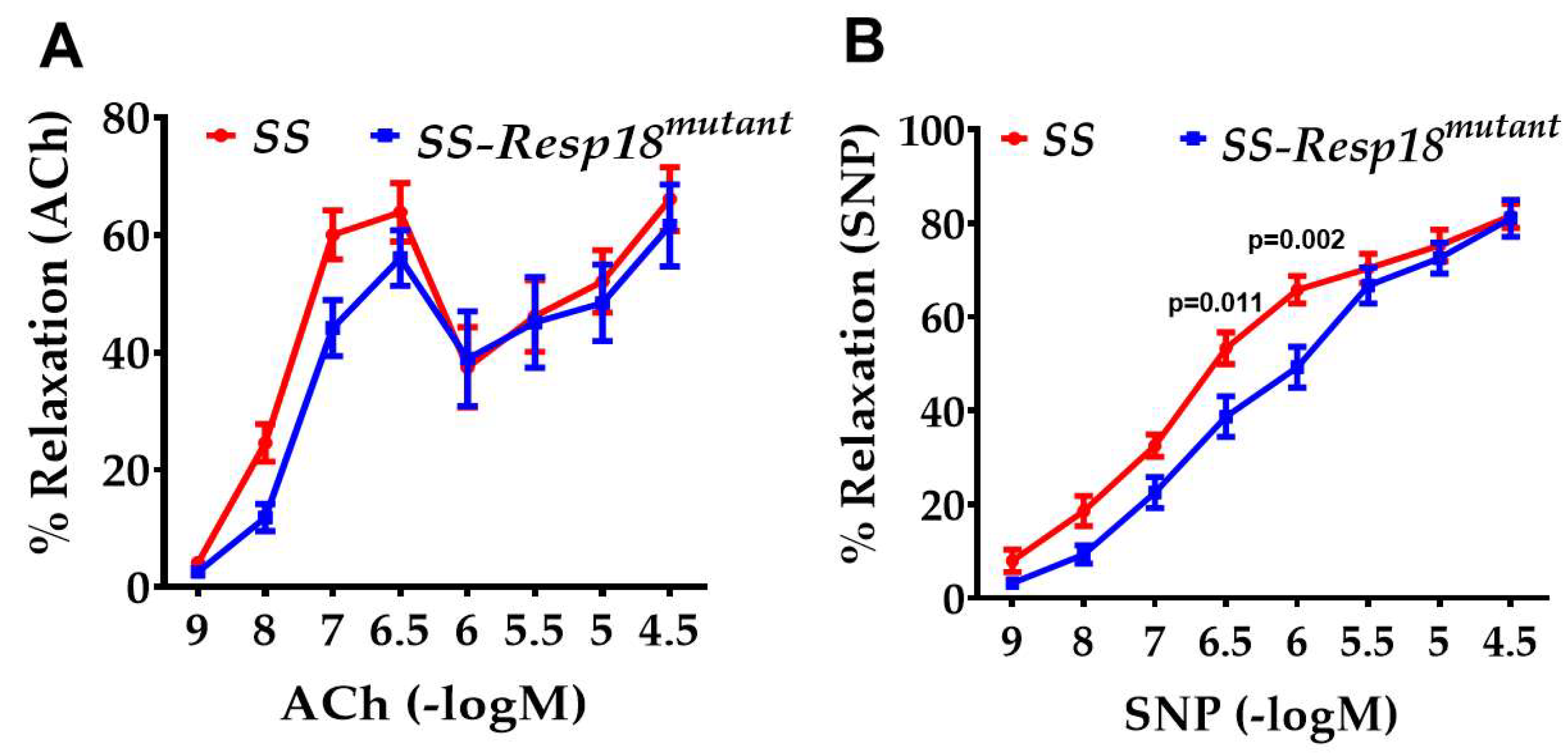
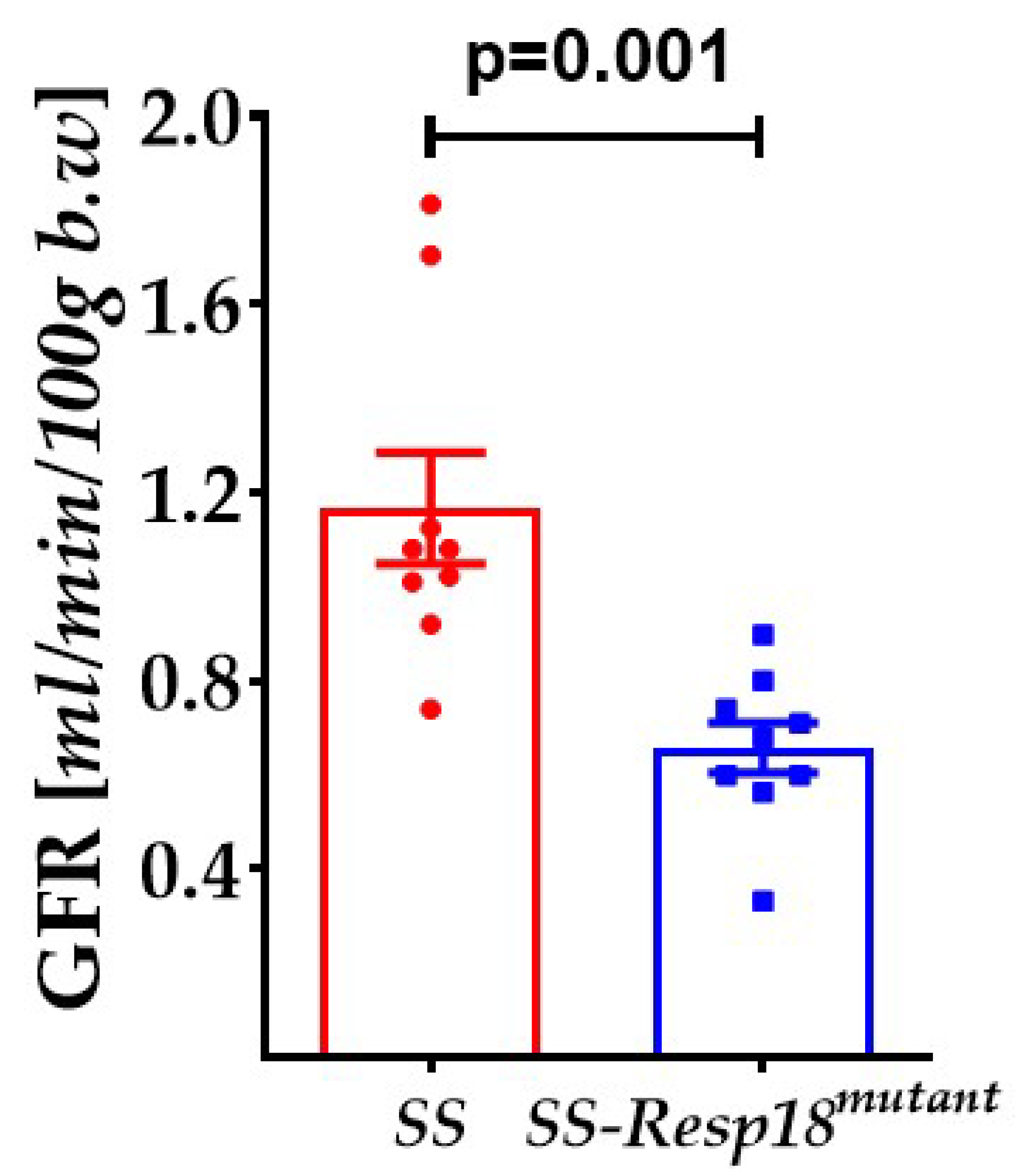

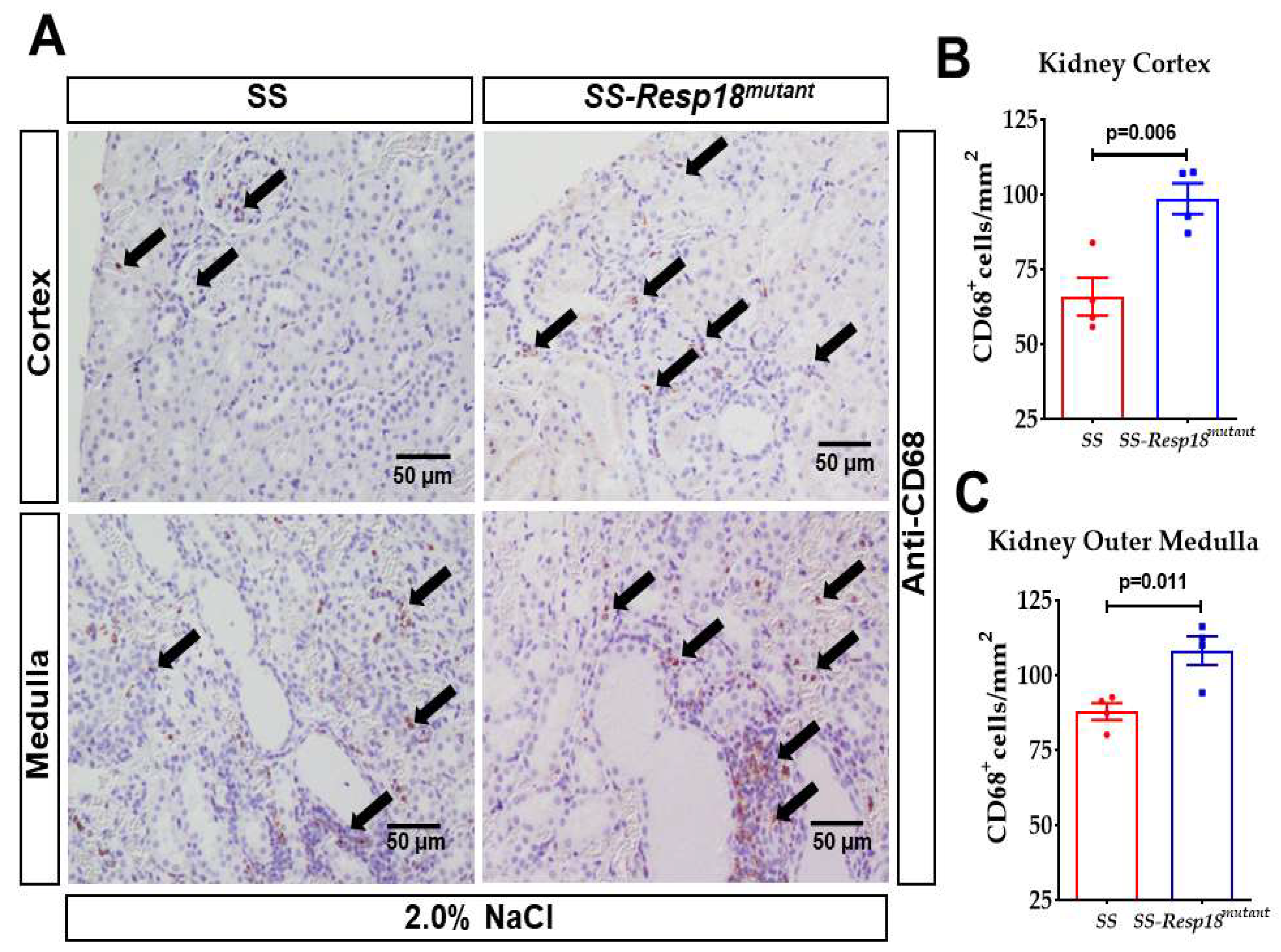
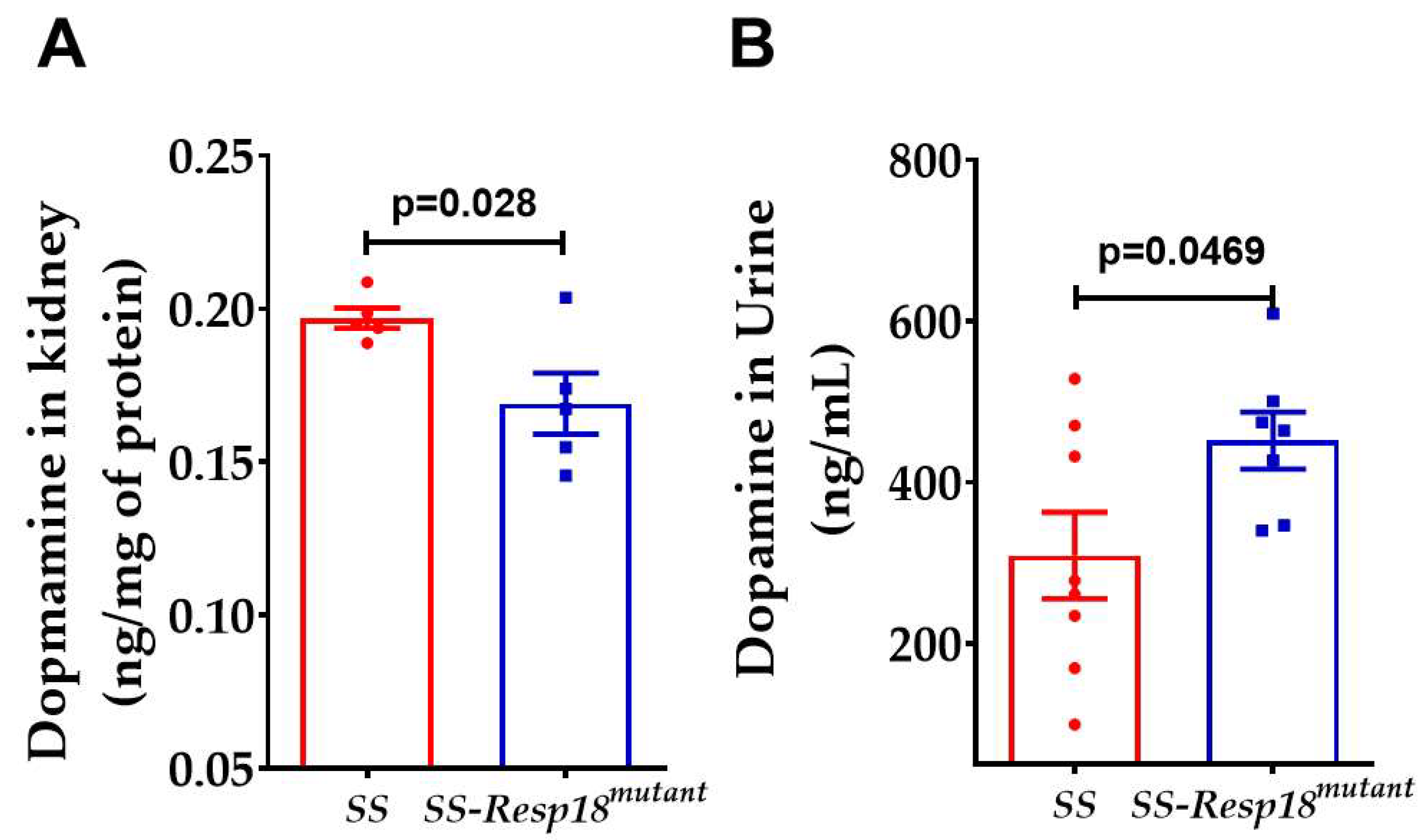
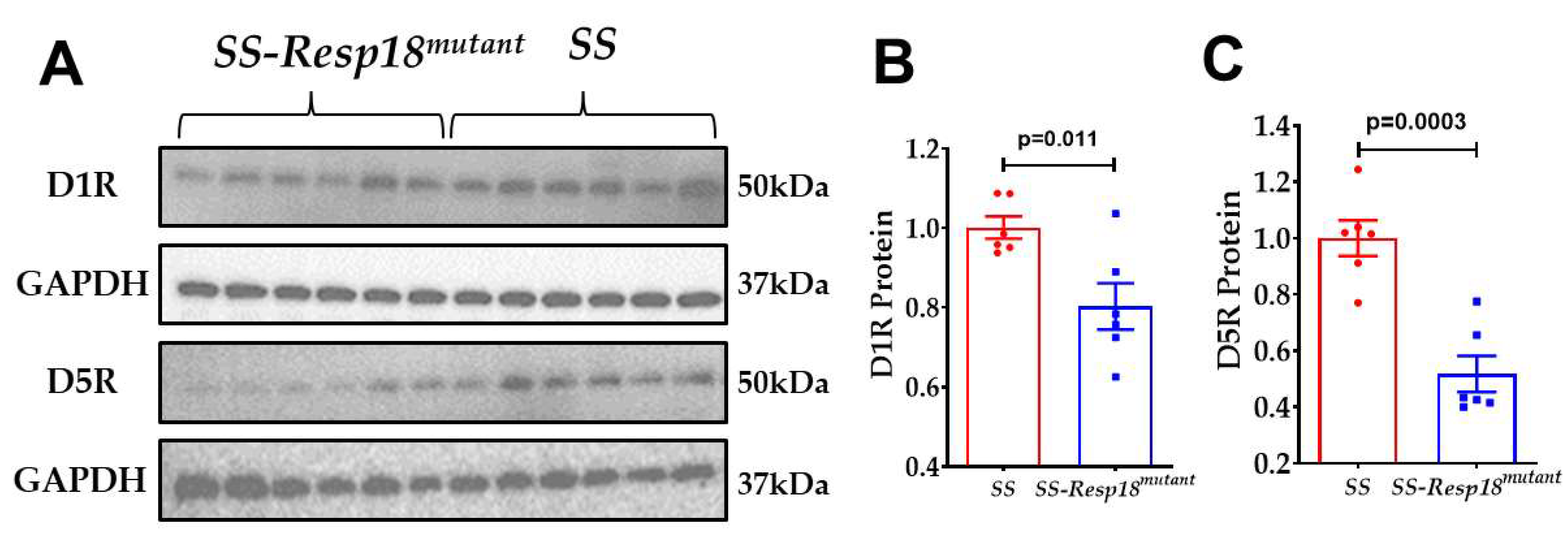

Disclaimer/Publisher’s Note: The statements, opinions and data contained in all publications are solely those of the individual author(s) and contributor(s) and not of MDPI and/or the editor(s). MDPI and/or the editor(s) disclaim responsibility for any injury to people or property resulting from any ideas, methods, instructions or products referred to in the content. |
© 2023 by the authors. Licensee MDPI, Basel, Switzerland. This article is an open access article distributed under the terms and conditions of the Creative Commons Attribution (CC BY) license (https://creativecommons.org/licenses/by/4.0/).
Share and Cite
Ashraf, U.M.; Atari, E.; Alasmari, F.; Waghulde, H.; Kumar, V.; Sari, Y.; Najjar, S.M.; Jose, P.A.; Kumarasamy, S. Intrarenal Dopaminergic System Is Dysregulated in SS-Resp18mutant Rats. Biomedicines 2023, 11, 111. https://doi.org/10.3390/biomedicines11010111
Ashraf UM, Atari E, Alasmari F, Waghulde H, Kumar V, Sari Y, Najjar SM, Jose PA, Kumarasamy S. Intrarenal Dopaminergic System Is Dysregulated in SS-Resp18mutant Rats. Biomedicines. 2023; 11(1):111. https://doi.org/10.3390/biomedicines11010111
Chicago/Turabian StyleAshraf, Usman M., Ealla Atari, Fawaz Alasmari, Harshal Waghulde, Vikash Kumar, Youssef Sari, Sonia M. Najjar, Pedro A. Jose, and Sivarajan Kumarasamy. 2023. "Intrarenal Dopaminergic System Is Dysregulated in SS-Resp18mutant Rats" Biomedicines 11, no. 1: 111. https://doi.org/10.3390/biomedicines11010111
APA StyleAshraf, U. M., Atari, E., Alasmari, F., Waghulde, H., Kumar, V., Sari, Y., Najjar, S. M., Jose, P. A., & Kumarasamy, S. (2023). Intrarenal Dopaminergic System Is Dysregulated in SS-Resp18mutant Rats. Biomedicines, 11(1), 111. https://doi.org/10.3390/biomedicines11010111









